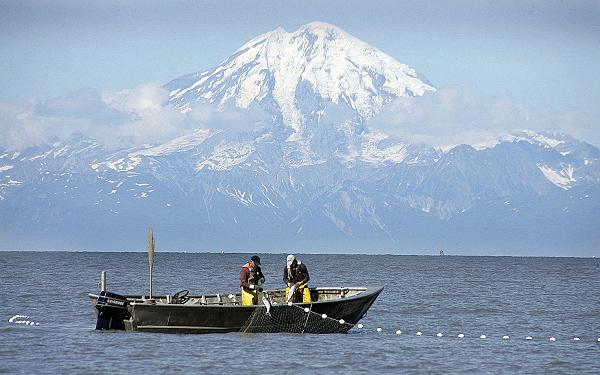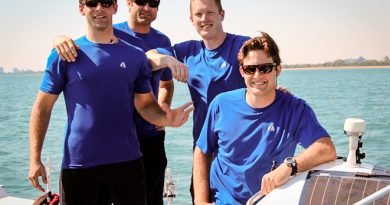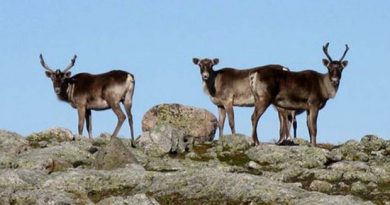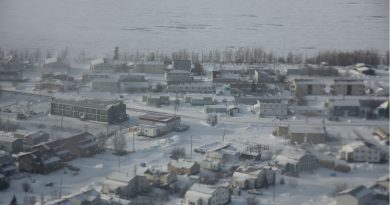ANALYSIS: Wild web-full of Alaska stories offers little in way of reality

What the hell? Was Monday, Aug. 5, the day the sky fell on Alaska? Consider all of what’s filtering up out of the Internet tubes from around the world thanks to the web-crawling robots of Google News.
• “Extreme Heat Is Killing Off Thousands Of Fish In Alaska.”
• “Relocation of Alaska’s sinking Newtok village halted.”
• “Destroy Alaska in Four Easy Steps: A U.S. Government Handbook.”
The latter story might be the best. Alaskans, particularly those who’ve visited the vast and now-deserted swath of land once known as the “Inland Empire” between the dying gold communities of Takotna and Ruby, might be surprised to learn that in the wake of the Gold Rush an “entire industry of miner towns, food and supply transport, and the like, grew up in the region, making long-term American-style habitation possible,” as that story claims.
“Alaska, with one of the most-fragile and, up to that point, pristine ecosystems in the world, had industrialized. Larger populations and large-scale, take what you need from the land and damn the consequences attitudes had come to roost in an ecologically sensitive land that could ill afford it.”
Aw, the “miner towns” — places like McCarthy, Skagway, Iditarod and Dikeman. Yes, Dikeman. Most people, Alaskans included, have probably never heard of it but there were about 5,000 miners tearing up the countryside around it in the early 1900s.
Today, you can’t find the place. At least Iditarod, a ghost town, can still be located, but that’s probably thanks to the fact the Iditarod Sled Dog Race runs through there every other year, which has helped the steadily decaying community hang onto a place on the map.
The community of Shield still has a place on some maps, too, though the people who drive past on the nearby Seward Highway, an official American scenic byway, think they’re looking at wilderness.
Not far down Canyon Creek from Shield in the direction of Hope was the community of Wibel. It’s all gone now, too. Community founder Simon Wibel did, however, make the Alaska Mining Hall of Fame, largely due to his ability to lay waste to the countryside. His biography credits him with introducing hydraulic mining to the Kenai.
“He recognized an extensive system of alluvial gravels on a bench about 100 feet above Canyon Creek and over the next several years developed the bench with flumes, pipe lines, and ditches. Boulders that would have hindered hand miners were pushed over the canyon walls into Canyon Creek by the force of hydraulic giants,” the bio says.
You can still find remnants of this activity if you look hard, but it’s not easy. The area looks like wilderness now. The land healed itself, and nearly all the people moved on to where there were new jobs. Even the Summit Lake Lodge, one of the few business left in the area, closes for the winter in mid-September.
So much for the changes brought by the Gold Rush.
Skagway and McCarthy both now survive thanks largely to their new roles as national park gateways. Skagway is at the northern end of the Klondike Gold Rush National Historic Park that starts in Seattle, and McCarthy is in the heart of the Wrangell-St. Elias National Park and Preserve, the world’s largest national park.
Those who know their Alaska history will immediately recognize that McCarthy was most famous for its copper, though there was plenty of gold-mining activity in the area, too. The nearly $200 million in high-grade copper processed through the nearby Kennecott Mine from 1911 to 1938, however, put the place on the map.
Then the Guggenheims and J.P. Morgan, the East Coast investors behind the mine, decided there were no more big riches to be had and shut it down almost over night. The Copper River and Northwestern Railway that had connected the community to Cordova on Prince William Sound quickly began to decay and disappear.
The remnants today — mainly the decaying remains of some trestles that still stand where railroad tracks used to run — are tourist attractions. So much for that system of “food and supply transport” from the heydays of mining.
It really wouldn’t arrive until the Second World War when the U.S. government, worried about the possibility Japan might seize the northwestern corner of the continent, decided to connect the then-territory to the rest of the country with the Alaska Highway.
A few interconnecting roads would follow in Alaska, but truth be told, there still isn’t much in the way of infrastructure in the 49th state. Most of the land remains wilderness. The “larger populations” of today number 731,449. More people live in Columbus, Ohio.
And of those 731,449 Alaskans, about half live in or around Anchorage, Alaska’s largest city. That leaves about 350,000 people scattered across a landscape about one and a quarter times bigger than Texas. Texas, it is worth noting, is home to more than 26 million people and is still thought of as a state with wide-open spaces.
But never mind. The bullshit that can get written about Alaska — excuse the language, but there is really no other word — seems endless.
That dead fish story? It notes that in addition to some salmon apparently killed by warm water in Southeast Alaska (or by crowding, which is unclear) weren’t the only fish to die in Alaska recently:
“Earlier in the summer, another hatchery lost hundreds of grayling and rainbow trout in a Fairbanks lake where water temperatures reached 76 degrees.”
Those fish, however, weren’t really “lost” at a hatchery or killed by warm water, they were killed by shock of being taken from the cold water of hatchery ponds and then placed in the warm water of lake.
And the Crystal Lake Hatchery, where the salmon died, is about 750 miles south of Fairbanks, which is close to the distance between Chicago and New Orleans. When is the last time you read about isolated events in Chicago and New Orleans being tied together to create an environmental trend?
The reporter obviously missed the 3 million or so red salmon that died in the heat on Kenai Peninsula in July. Sure, they were pulled out the water and beat about the head by commercial, personal use and sport fishermen before they died. But it was unusually hot in Alaska this year, and they did die, right?
And there’s hardly thing more fun for today’s media than “making things up,” as former Alaska Gov. Sarah Palin used to say on her way to becoming an expert at making things up.
Contact Craig Medred at craig(at)alaskadispatch.com



